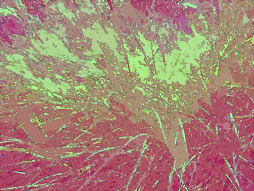First man ‘functionally cured’ of HIV. Found it through Americablog. Cool on several levels. Someone has been "cured" of HIV--Really good for him, right? This result provides new pathways of research and medical direction in future conventional treatment. And score another victory for stem cell research! All good.
It also establishes, rather firmly, too, that a percentage of people have some-to-possibly-total resistance. From Wired's article Genetic HIV Resistance Deciphered
Studies released this week and last year suggest that the roots of AIDS immunity extend back for centuries, long before the disease even existed. Our ethnic backgrounds and the illnesses suffered by our distant ancestors appear to play a crucial role in determining whether our genes will allow HIV to take hold in our bodies.
..
All those with the highest level of HIV immunity share a pair of mutated genes -- one in each chromosome -- that prevent their immune cells from developing a "receptor" that lets the AIDS virus break in. If the so-called CCR5 receptor -- which scientists say is akin to a lock -- isn't there, the virus can't break into the cell and take it over.
To be protected, people must inherit the genes from both parents; those who inherit a mutated gene from just one parent will end up with greater resistance against HIV than other people, but they won't be immune. An estimated 10 percent to 15 percent of those descended from Northern Europeans have the lesser protection.
This foundational assumption which is integral to this new development's understanding, contradicts some of the conventional wisdom associated with the virus: All are equal in the cross hairs of HIV. Heterosexuals never fully bought into the epidemic panic (not for themselves, anyway..), but mainstream medicine scoffed at alternative theories, and suppressed information by not financially backing any data not in line with "HIV=AIDS," including theories about HIV having Nothing To Do with AIDS..
This information is not new. From 1992:
Another possibility is that HIV doesn't have anything to do with AIDS. This is what Peter Duesberg of UC Berkeley has been saying for five years: that HIV doesn't attack the immune system, doesn't cause AIDS, and is in fact harmless. A professor of molecular biology, Duesberg is one of the world's leading experts on retroviruses. I called him at his Berkeley lab and asked what he thought of the news from Amsterdam, and the possibility that we may now have one more lethal virus to worry about.
..
Duesberg is a member of the National Academy of Sciences and was the first to map the genetic structure of retroviruses. He is not popular with the National Institutes of Health, the government agency that has been funding and policing AIDS research for the last decade. For years he was supported by an NIH "outstanding investigator" grant, but after he attacked the HIV theory of AIDS, his grant was cut off.
Down the hall from Duesberg at Berkeley's Stanley Hall is the lab of Professor Harry Rubin, another skeptic. He also believes that HIV has not been shown to be the cause of AIDS. I spoke to Bryan Ellison, a doctoral candidate with Rubin. Retroviruses have never been observed to kill cells, he told me. If you microscopically examine healthy cells in a dish, and a virus such as polio is added to them, the virus multiplies inside the cells and bursts them open in a matter of hours. Soon you can see nothing but "debris and garbage and dead cells," he said. But if you put HIV, or any other retrovirus, into the same dish with healthy cells-an environment where the body's immune system cannot interfere-the cells just sit there and continue healthy growth.
..
Something has been attacking the immune system, he agrees. The T-cells of AIDS patients do dwindle away, and there has been an increase in such opportunistic diseases as pneumocystis in the past decade. But HIV has never been shown physically to attack T-cells. The virus in fact is very difficult to find, even in patients dying of AIDS. Usually only antibodies can be detected-which is why an antibody test is used for HIV. Indications are that HIV is swiftly neutralized by the body's defenses. Yet it is said to kill after a ten-year (average) latency period. This has been lengthened to account for the failure of AIDS cases to keep pace with projections. Another oddity: researchers still have no "animal model" for AIDS. Over one hundred chimps have been infected with HIV since 1985 -- and the virus does "take," or replicate within them-but none has yet come down with AIDS.
..
Duesberg also makes the following claims: there are no cases in the medical literature of health-care workers contracting AIDS through accidental needle-stick. In a footnote to its latest AIDS report, the CDC says there have been four such cases, but they have not been identified or described. There are a few disputed cases in the courts "and they want their money," Duesberg says. By contrast, about 15,000 cases of needle-stick hepatitis infection are reported every year.
..
About 75 per cent of the 20,000 U.S. hemophiliacs are HIV-positive, but there has still not been a properly controlled study of them. Do those with HIV come down with more AIDS diseases, or die sooner, than those without? It has been found that hemophiliacs in general are living longer than ever, even though three-fourths are now infected with the "deadly virus" and virtually all of these have been infected for eight years or more. Since the relevant data are already in place and await only statisticians, perhaps NIH could spend some of its research billions on a hemophiliac study.
"There is not a single controlled epidemiological study to confirm the postulated viral etiology of AIDS," Duesberg wrote in 1990. True? San Francisco's Project Inform recently put out a discussion paper, very critical of Duesberg, referring to "studies" comparing HIV-infected homosexuals with uninfected controls with "similar patterns of drug use and frequency of sexual contacts." None of the latter came down with AIDS, apparently. These studies were not identified or footnoted, so I phoned Martin Delaney, the executive director of Project Inform, and asked for the reference.
His "source," it turned out, was a person, not a paper. He gave me the name of a doctor who is identified in Randy Shilts's book, And the Band Played On, as having helped persuade CDC a decade ago that AIDS was caused by a virus. I phoned him but so far haven't heard back.
Delaney seemed dismayed that journalists were interested in Duesberg. I mentioned the series of articles that came out recently in the (London) Sunday Times about Duesberg and his critics. "When the Sunday Times publicizes what Duesberg says," Delaney replied, paradoxically, "it has an obligation to ask, 'What is your source for this?' They don't apply skepticism."
I spoke to Neville Hodgkinson, the Sunday Times's science correspondent and author of the series. He said he had never checked anything so carefully before publication. He was concerned that there might be a study he didn't know about. "What was the response?" I asked.
"Anger and indignation, but no factual rebuttal," he said. "I've never seen anything like it." He was solemnly told that there is a "consensus" that HIV causes AIDS, and it shouldn't be challenged.
Ultimately, we're closer to a cure to whatever AIDS is because of doctors and scientists who couldn't accept the Official Story, those strong enough to follow the data through through the shitrain opposition that is Institutionalized Thought Under Attack. Those strong enough to continue their work for the truth of it.
Maybe this is the beginning of Their time.
It also establishes, rather firmly, too, that a percentage of people have some-to-possibly-total resistance. From Wired's article Genetic HIV Resistance Deciphered
Studies released this week and last year suggest that the roots of AIDS immunity extend back for centuries, long before the disease even existed. Our ethnic backgrounds and the illnesses suffered by our distant ancestors appear to play a crucial role in determining whether our genes will allow HIV to take hold in our bodies.
..
All those with the highest level of HIV immunity share a pair of mutated genes -- one in each chromosome -- that prevent their immune cells from developing a "receptor" that lets the AIDS virus break in. If the so-called CCR5 receptor -- which scientists say is akin to a lock -- isn't there, the virus can't break into the cell and take it over.
To be protected, people must inherit the genes from both parents; those who inherit a mutated gene from just one parent will end up with greater resistance against HIV than other people, but they won't be immune. An estimated 10 percent to 15 percent of those descended from Northern Europeans have the lesser protection.
This foundational assumption which is integral to this new development's understanding, contradicts some of the conventional wisdom associated with the virus: All are equal in the cross hairs of HIV. Heterosexuals never fully bought into the epidemic panic (not for themselves, anyway..), but mainstream medicine scoffed at alternative theories, and suppressed information by not financially backing any data not in line with "HIV=AIDS," including theories about HIV having Nothing To Do with AIDS..
This information is not new. From 1992:
Another possibility is that HIV doesn't have anything to do with AIDS. This is what Peter Duesberg of UC Berkeley has been saying for five years: that HIV doesn't attack the immune system, doesn't cause AIDS, and is in fact harmless. A professor of molecular biology, Duesberg is one of the world's leading experts on retroviruses. I called him at his Berkeley lab and asked what he thought of the news from Amsterdam, and the possibility that we may now have one more lethal virus to worry about.
..
Duesberg is a member of the National Academy of Sciences and was the first to map the genetic structure of retroviruses. He is not popular with the National Institutes of Health, the government agency that has been funding and policing AIDS research for the last decade. For years he was supported by an NIH "outstanding investigator" grant, but after he attacked the HIV theory of AIDS, his grant was cut off.
Down the hall from Duesberg at Berkeley's Stanley Hall is the lab of Professor Harry Rubin, another skeptic. He also believes that HIV has not been shown to be the cause of AIDS. I spoke to Bryan Ellison, a doctoral candidate with Rubin. Retroviruses have never been observed to kill cells, he told me. If you microscopically examine healthy cells in a dish, and a virus such as polio is added to them, the virus multiplies inside the cells and bursts them open in a matter of hours. Soon you can see nothing but "debris and garbage and dead cells," he said. But if you put HIV, or any other retrovirus, into the same dish with healthy cells-an environment where the body's immune system cannot interfere-the cells just sit there and continue healthy growth.
..
Something has been attacking the immune system, he agrees. The T-cells of AIDS patients do dwindle away, and there has been an increase in such opportunistic diseases as pneumocystis in the past decade. But HIV has never been shown physically to attack T-cells. The virus in fact is very difficult to find, even in patients dying of AIDS. Usually only antibodies can be detected-which is why an antibody test is used for HIV. Indications are that HIV is swiftly neutralized by the body's defenses. Yet it is said to kill after a ten-year (average) latency period. This has been lengthened to account for the failure of AIDS cases to keep pace with projections. Another oddity: researchers still have no "animal model" for AIDS. Over one hundred chimps have been infected with HIV since 1985 -- and the virus does "take," or replicate within them-but none has yet come down with AIDS.
..
Duesberg also makes the following claims: there are no cases in the medical literature of health-care workers contracting AIDS through accidental needle-stick. In a footnote to its latest AIDS report, the CDC says there have been four such cases, but they have not been identified or described. There are a few disputed cases in the courts "and they want their money," Duesberg says. By contrast, about 15,000 cases of needle-stick hepatitis infection are reported every year.
..
About 75 per cent of the 20,000 U.S. hemophiliacs are HIV-positive, but there has still not been a properly controlled study of them. Do those with HIV come down with more AIDS diseases, or die sooner, than those without? It has been found that hemophiliacs in general are living longer than ever, even though three-fourths are now infected with the "deadly virus" and virtually all of these have been infected for eight years or more. Since the relevant data are already in place and await only statisticians, perhaps NIH could spend some of its research billions on a hemophiliac study.
"There is not a single controlled epidemiological study to confirm the postulated viral etiology of AIDS," Duesberg wrote in 1990. True? San Francisco's Project Inform recently put out a discussion paper, very critical of Duesberg, referring to "studies" comparing HIV-infected homosexuals with uninfected controls with "similar patterns of drug use and frequency of sexual contacts." None of the latter came down with AIDS, apparently. These studies were not identified or footnoted, so I phoned Martin Delaney, the executive director of Project Inform, and asked for the reference.
His "source," it turned out, was a person, not a paper. He gave me the name of a doctor who is identified in Randy Shilts's book, And the Band Played On, as having helped persuade CDC a decade ago that AIDS was caused by a virus. I phoned him but so far haven't heard back.
Delaney seemed dismayed that journalists were interested in Duesberg. I mentioned the series of articles that came out recently in the (London) Sunday Times about Duesberg and his critics. "When the Sunday Times publicizes what Duesberg says," Delaney replied, paradoxically, "it has an obligation to ask, 'What is your source for this?' They don't apply skepticism."
I spoke to Neville Hodgkinson, the Sunday Times's science correspondent and author of the series. He said he had never checked anything so carefully before publication. He was concerned that there might be a study he didn't know about. "What was the response?" I asked.
"Anger and indignation, but no factual rebuttal," he said. "I've never seen anything like it." He was solemnly told that there is a "consensus" that HIV causes AIDS, and it shouldn't be challenged.
Ultimately, we're closer to a cure to whatever AIDS is because of doctors and scientists who couldn't accept the Official Story, those strong enough to follow the data through through the shitrain opposition that is Institutionalized Thought Under Attack. Those strong enough to continue their work for the truth of it.
Maybe this is the beginning of Their time.









































































































No comments:
Post a Comment